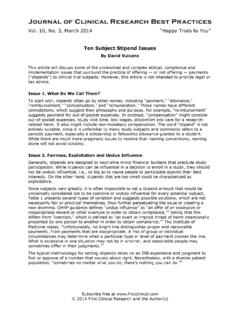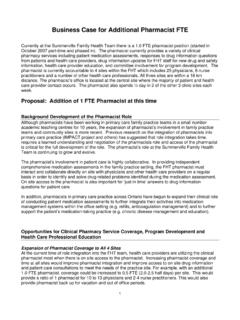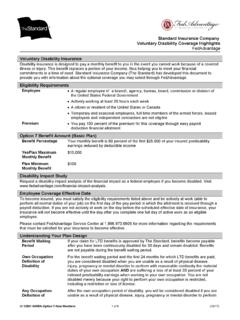Transcription of PHYSICIAN GOVERNANCE & EFFECTIVE BLOCK …
1 PHYSICIAN GOVERNANCE &. EFFECTIVE BLOCK SCHEDULING. IN THE SURGICAL SUITE. BY DR. JAMES KETTERHAGEN & PAULA BISHOP. A strong Operating Room Executive Committee (OREC) can support the perioperative leadership team and enable the OR to continue - or regain - its strong contribution to the Business hospital's bottom line, which for many providers is upward of 70%. This white paper demonstrates the value of a strong OREC for EFFECTIVE BLOCK scheduling, an EFFECTIVE way Intelligence to optimize the surgery schedule, enhance surgeon satisfaction and retention, and and Clinical increase surgical volumes and revenue. Excellence Value of PHYSICIAN Engagement in the Surgical Suite Consistent complaints heard from surgeons: w No one listens to my suggestions.
2 W If I were in charge of the OR, things would run smoothly . w They do whatever they want regardless of what I tell them . While such expressions of frustration are often shrouded in emotion, their origin rests in the fact that in many operating rooms, the surgeons really have very little authority or ability to influence processes. The OR is the surgeon's workshop and their patients are the lifeblood of a hospital's financial stability but despite this, operational deci- sions are often made by administrators and managers outside of the surgeon's sphere of influence. The solution to this problem comes in a well designed, highly EFFECTIVE Operating Room Executive Committee (OREC). OREC is NOT a traditional OR committee in which surgeons gather primarily to have a meal, vent their frustrations and share stories but have little or no decision-making ability.
3 The essential elements of a high-performance OREC are: w Authority (granted and supported by senior executive leadership) to Through empowerment and Toll Free: make operational decisions in 866-747-4200 partnership with departmental accountability, the PHYSICIAN -led O ce: management OREC group leads the 858-486-6030 w Members are appointed based on transformation, achieves the their leadership skills and ability to goals, and ensures sustainable work cooperatively in the best outcomes. interest of both surgeons and the hospital Dr. James Ketterhagen w OREC is an administrative committee, not a medical staff committee w While OREC may offer advice, their authority does not include personnel discipline, salary or departmental budget w Similarly, PHYSICIAN quality issues are addressed through the medical staff peer review process, not OREC.
4 OREC Activities & Operating Case study: How the Operating Room Executive Committee Principles Can Effectively Manage BLOCK Scheduling This white paper describes the process and successful outcomes resulting from What OREC Does the OREC management of BLOCK scheduling at a 302-bed, 11-room OR, non-profit w Establishes Rules and Regulations community hospital. (R&R) governing Perioperative The purpose of the Operating Room Executive Committee in relation to BLOCK environment functions : schedule management is to approve policies, review utilization data on a monthly - Hours of operations basis, and adjust allocated blocks as outlined in the policy. This white paper - Number of rooms available defines the contents of an EFFECTIVE BLOCK scheduling system and the necessary - BLOCK utilization elements to manage it effectively.
5 The data illustrates improved BLOCK utilization after implementation of the new policies and monthly review by OREC. - Requirements for pre- admission testing The OREC developed and approved a BLOCK scheduling policy that clearly defined - Establishes key terms and expectations for surgeons with allocated BLOCK time. To ensure transparency, the definitions OREC mailed a letter to each surgeon introducing revisions to the surgery sched- - Determines core metrics and uling and BLOCK scheduling policies, including the expected benefits to these benchmarks changes. This same information was presented to the Department of Surgery Steering Committee. The new BLOCK Scheduling policy went into effect 5/1/2012. - Reviews performance improvement plans for poor Open, clear, concise communication is paramount to the success of BLOCK core metric performance, late management.
6 Surgeons receive a monthly letter outlining their BLOCK utilization, arrivers, or poor behavior which includes voluntary BLOCK release time. The OREC reviews surgeons at risk . w Examines and revises policies that for losing all or a portion of their BLOCK time at the monthly meetings. Those may impact quality surgeons are then notified that they are in jeopardy, and that their blocks will be w Communicates the R&R of the adjusted in the next quarter if their utilization does not improve. Once the OREC. Perioperative Environment to makes the BLOCK adjustments, a letter is sent to the affected surgeons outlining fellow medical sta members their new BLOCK schedule. This facilitates the EFFECTIVE management of BLOCK time w Enforces R&R among medical sta.
7 In a standardized, collegial manner. members Results The number of PHYSICIAN blocks noted at risk each month gradually decreased from 20 to 9 by the end of 2013. Adjusted utilization increased from below 70%. through 2012 and consistently remained between 70%-80% for 2013. Voluntary release time decreased from over 20% to a monthly average of 10%. It should be noted that Adjusted utilization is the actual patient in-room time plus patient out to patient in time, divided by the total BLOCK minutes available, minus case run over minutes, minus voluntary release time. Actual utilization is actual patient in room time plus patient out to patient in time, divided by the total BLOCK minutes available. Results (continued). OREC Responsibilities Related to BLOCK Management w Administration of the BLOCK scheduling policy w Allocation of BLOCK time to surgeons or groups w Monitoring of BLOCK utilization w Adjusting BLOCK allocation based on actual utilization Expectations of OREC Members w Start and end on time w Attendance is mandatory no delegation w Consensus among all is the objective (consensus complete agreement).
8 W Open and honest communica- tion w No hidden agendas w Success of surgical department as a whole drives the work w All must use agreed email Strategies for Implementation address w Goal of standardized, collegial management of BLOCK allocation and scheduling w The OREC developed and approved BLOCK scheduling policy outlining clearly defined expectations for surgeons with allocated BLOCK time - Automatic release times based on specialty - Definition of voluntary release - Utilization rate of 75% or higher required to retain BLOCK time - Explanation of BLOCK utilization calculation w Transparency - Letter to surgeons introducing revisions to surgery scheduling and BLOCK scheduling policies and expected benefits - Presentation of information to Department of Surgery Steering Committee w New BLOCK scheduling policy went into effect 5/1/2012.
9 W Clear, concise, open communication is paramount to the success of BLOCK management - Surgeons receive a monthly letter outlining BLOCK utilization, including voluntary BLOCK release time w Monthly review during OREC meeting of surgeons at risk for losing all or a portion of their BLOCK time allocation w Surgeons are notified that they are in jeopardy and that blocks may be adjusted in the next quarter if their utilization does not improve w When the OREC makes BLOCK adjustments, a letter is sent to the affected surgeons providing their new BLOCK schedule Lessons Learned w The OREC outlined in this essay takes time to create. Spending the first few meetings establishing the purpose, authority and workplan for the committee before beginning to tackle a more di cult policy issue like BLOCK scheduling is Business essential.
10 Intelligence w Selection of the right membership is essential. There is no room for personal agendas on the committee. and Clinical w The highest level of administrative leadership (we recommend the CEO) should Excellence attend and participate in all meetings. The CEO can chair the committee initially, transferring that responsibility to a PHYSICIAN leader once the committee is well established. w Anesthesia needs to be represented in OREC. w Surgical Services management should be active participants in all meetings. Conclusion Novia consultants have assisted surgical departments across the country in re- engaging surgeons and anesthesiologists in the management of their workplace through the establishment of high-performance Operating Room Executive Committees.






